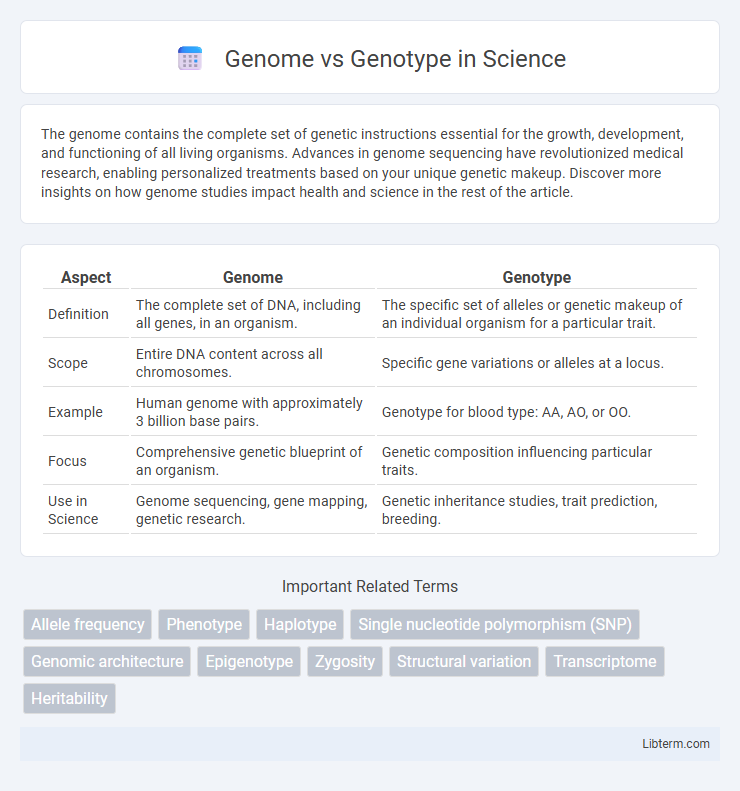The genome contains the complete set of genetic instructions essential for the growth, development, and functioning of all living organisms. Advances in genome sequencing have revolutionized medical research, enabling personalized treatments based on your unique genetic makeup. Discover more insights on how genome studies impact health and science in the rest of the article.
Table of Comparison
| Aspect | Genome | Genotype |
|---|---|---|
| Definition | The complete set of DNA, including all genes, in an organism. | The specific set of alleles or genetic makeup of an individual organism for a particular trait. |
| Scope | Entire DNA content across all chromosomes. | Specific gene variations or alleles at a locus. |
| Example | Human genome with approximately 3 billion base pairs. | Genotype for blood type: AA, AO, or OO. |
| Focus | Comprehensive genetic blueprint of an organism. | Genetic composition influencing particular traits. |
| Use in Science | Genome sequencing, gene mapping, genetic research. | Genetic inheritance studies, trait prediction, breeding. |
Introduction to Genome and Genotype
Genome refers to the complete set of DNA within an organism, encompassing all genes and non-coding sequences that provide the blueprint for biological functions and inheritance. Genotype specifically denotes the genetic makeup of an individual organism, representing the particular alleles inherited from parents at specific loci. Understanding the distinction between genome and genotype is crucial for studies in genetics, molecular biology, and personalized medicine.
Defining the Genome
The genome encompasses the complete set of DNA within an organism, including all of its genes and non-coding sequences that regulate gene expression and maintain chromosomal structure. It serves as the full genetic blueprint that dictates biological traits and cellular functions. Defining the genome precisely involves sequencing the entire DNA content to understand both hereditary information and genomic variations.
Understanding Genotype
Genotype represents the specific genetic constitution of an organism, consisting of the alleles inherited from both parents, which directly influence traits and characteristics. Unlike the genome, which encompasses the entire DNA sequence, the genotype refers to the particular set of genes responsible for observed phenotypes. Understanding genotype helps in studying hereditary diseases, genetic variations, and individual responses to environmental factors.
Genome vs Genotype: Key Differences
Genome refers to the complete set of DNA, including all of its genes, in an organism, while genotype specifically denotes the genetic makeup of a particular individual or organism concerning specific traits. The genome encompasses the entire hereditary information stored in an organism's chromosomes, whereas genotype highlights the variations or alleles present at particular loci that influence phenotype. Understanding these differences is essential in fields like genetics, medicine, and evolutionary biology for interpreting genetic data and disease susceptibility.
The Role of DNA in Genome and Genotype
DNA constitutes the complete set of genetic material within an organism, defining its genome, which encompasses all genes and non-coding sequences. The genotype specifically refers to the unique combination of alleles inherited from parents that determine particular traits. Understanding the interplay between DNA sequences in the genome and the resulting genotype enables advances in genetics, personalized medicine, and evolutionary biology.
How Genotypes Influence Traits
Genotypes determine specific genetic variations within an organism's genome, directly influencing physical traits, biochemical processes, and susceptibility to diseases. The interaction of multiple genes within a genotype shapes characteristics such as eye color, height, and metabolism by regulating protein production and gene expression. Environmental factors often modulate these genetic influences, but the underlying genotype remains the primary blueprint dictating hereditary traits.
Genome Sequencing and Its Applications
Genome sequencing involves determining the complete DNA sequence of an organism's genome, providing a comprehensive map of all its genetic material. Genotype refers to the specific set of genes or genetic variants within an organism, influencing traits and disease susceptibility. Applications of genome sequencing include personalized medicine, identification of genetic disorders, evolutionary biology studies, and advancements in agriculture through genome editing and crop improvement.
Genotyping Techniques and Analysis
Genotyping techniques include PCR-based methods, microarrays, and next-generation sequencing (NGS), enabling precise identification of genetic variants within an individual's genotype. Analysis of genotype data involves bioinformatics tools that interpret single nucleotide polymorphisms (SNPs), insertions, deletions, and copy number variations to understand genetic predispositions and traits. Genome sequencing provides a comprehensive overview of an organism's complete DNA sequence, whereas genotyping focuses on specific genomic regions to assess genetic diversity and variant frequencies efficiently.
Clinical and Research Implications
Genome analysis enables comprehensive identification of genetic variations influencing disease susceptibility and treatment response, providing crucial insights for personalized medicine in clinical settings. Genotype profiling focuses on specific allelic variants to predict phenotypic traits and drug metabolism, enhancing precision diagnostics and targeted therapy strategies. Research implications include leveraging whole-genome sequencing for novel biomarker discovery and using genotype data to elucidate gene-environment interactions in complex diseases.
Future Perspectives in Genomics and Genotyping
Advancements in genome sequencing technologies and computational genomics are propelling personalized medicine by enabling precise genotyping of large populations, uncovering complex genetic architectures underlying diseases. Integrating multi-omics data with high-resolution genotypic profiles facilitates the development of predictive models for tailored therapeutics and preventive strategies. Future perspectives center on scalable, cost-effective genomics approaches combined with artificial intelligence to accelerate genotype-phenotype correlations and enhance global healthcare outcomes.
Genome Infographic

 libterm.com
libterm.com